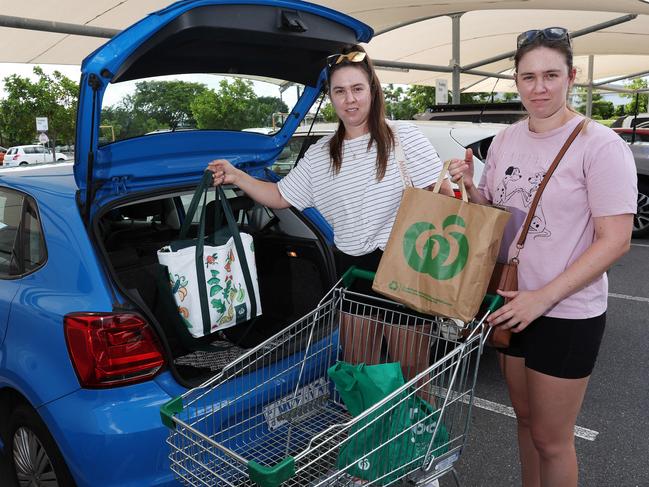Sentiment Survey: What we’re going without in cost-of-living battle
Twice as many Queenslanders are struggling to pay their mortgage or rent than were three years ago, and seven in 10 have ditched grocery items to manage soaring cost-of-living pressures.
QLD News
Don't miss out on the headlines from QLD News. Followed categories will be added to My News.
Twice as many Queenslanders are struggling to pay their mortgage or rent than were three years ago, and seven in 10 have ditched grocery items to manage soaring cost-of-living pressures.
The Courier-Mail’s sentiment survey has once again lifted the lid on the fears and concerns for thousands of Queenslanders, revealing the enormous financial burden engulfing households across the state.
Of the nearly 7000 respondents, almost 40 per cent said they had struggled to pay their mortgage, rent or bills in the past 12 months.
The alarming figure was almost double that reported in the corresponding sentiment survey in late 2020 and was revealing of the extent the housing crisis has plagued the state.
Interest rates have soared from 0.1 per cent in May 2022 to 4.35 per cent following 13 rate rises by the Reserve Bank of Australia.
Living costs has also been another weight on household budgets and this was reflected in the massive survey – nearly 98 per cent said their groceries were more expensive, with nearly 40 per cent saying the shop had increased by up to $100.
This pressure on the weekly shop forced 70 per cent to cut back on grocery items, with meat being the most often sacrificed from the trolley by nearly 34 per cent of respondents.
More than 80 per cent have cut back on other expenses such as insurance and using electricity, which Queensland Council of Social Service chief executive Aimee McVeigh said was “absolutely not surprising” given the acute pressure on families.
“It is certainly is the case that people who have jobs and who had previously experienced a decent standard of living are under financial pressure that they hadn’t expected to be under,” she told The Courier-Mail.
“It is the case now that having a full time job doesn’t necessarily guarantee that you can afford the basic cost of living We know that working families, right now, are even foregoing housing – people who are working are living in cars and tents
“We know that older people, for example, make really tricky choices at this time of year not to turn airconditioning on because of the costs of electricity when they’re balancing up having to afford the other basic costs of living.”
For twin sisters Tyler and Miller Ferris, 27, from Hendra, they’ve had to become smarter with their shopping habits.
“We plan more, we’re looking at sales and planning our meals ahead so we’re not so wasteful … it’s about being smarter,” Tyler said.
“We also stock up on things when they’re on specials, like cosmetics and shampoos.
Miller added that, “looking at the quick sale meats,” had helped them plan out their shopping better.
“Our freezer is full of quick sale meats, and I find we’re looking at the catalogues a lot more now.”
Tyler said the pair, along with her partner and a friend, all live together in a house in Hendra.
“My sister and I were going to buy a house 12 months ago, but the interest rates went up.
“Four of us are living together now to save money to hopefully look at buying again soon.”
Ms McVeigh said the peak body for social services has experienced a sharp increase in demand for people in need of emergency relief.
“Our community organisations across Queensland are saying that people with mortgages and people with jobs are seeking support and that is a real change in demographics from the people that our organisations are familiar with or are used to providing services to,” she said.
“Around a third of Queenslanders rent, and that is increasing, and we also know that there isn’t enough supply of rental properties in Queensland to match the ever increasing demands.
“What that means is more and more working Queenslanders are priced out of the private rental market, and, put simply, that means people who have jobs can’t afford to pay the rent.”

Q Shelter, the state’s peak body for homeless support, echoed Ms McVeigh’s alarming assessment of the depth of despair facing a wide range of Queenslanders.
“Our members have been telling us that it’s not just the bottom two income quintiles that are seeking support for services and housing right now, but people higher up the income distribution who have two incomes in the household and full-time work,” the body’s policy and strategic engagement manager, Jackson Hills, said.
“They are struggling to pay their rent and mortgage, with very little left over to save for a rainy day.
“This rise in financial strain has been observed across all demographics, including youth, mature age, women, people with disabilities, First Nations people, single men, and families.”
Mr Hills said the cost-of-living pressures were compounded by the constraints to the building industry, which has crippled the supply of much-needed new housing.
“There are some well-articulated reasons for this, including high construction costs, a lack of workforce, and other cost pressures,” he said.
“While there has never been a greater convergence of work around responding to homelessness, increasing housing supply, and streamlining planning measures in our state – these challenges persist.
Treasurer Cameron Dick flagged future cost of living relief.
“We will always look to do more to support Queenslanders who are doing it tough,” he said.
“The announcements the Premier and I have made since our appointment indicate that of course we’re going to focus on cost of living.”
Originally published as Sentiment Survey: What we’re going without in cost-of-living battle
Read related topics:Cost Of Living




